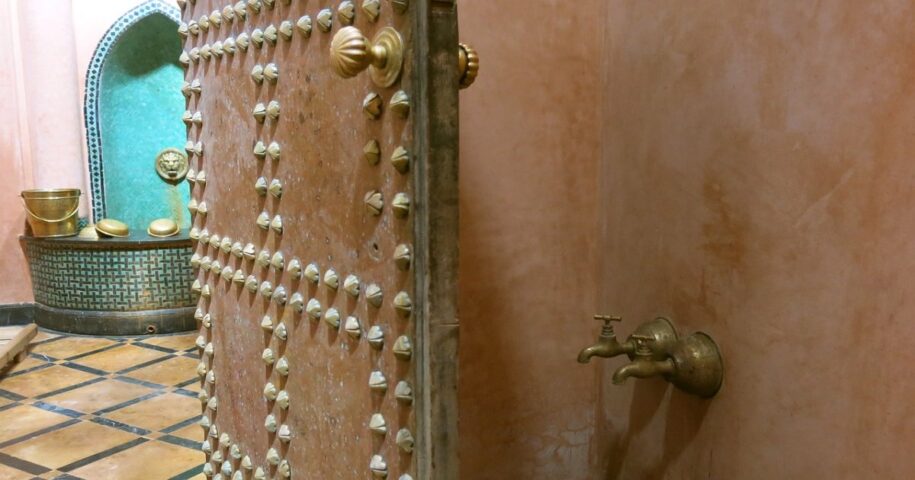Moroccan Hammam history:
The Moroccan hammam is a traditional way to bathe and clean that dates back hundreds of years. The term “hammam” comes from the Arabic word for “heat” and refers to a steam bath or a public washing facility.
The hammam has its roots in ancient Rome and Greece, where communal bathing was popular. When they conquered the region in the first century AD, the Romans introduced the concept to North Africa. However, the hammam became an integral element of Moroccan society and culture during the Islamic period.
With the spreading of Islam in the seventh century, the practice of regular ablutions became an essential component of Islamic hygiene and purification rituals. People were able to cleanse their bodies, purify their spirits, and engage in social interactions in the hammam. It also served as a place for women to gather and share news and experiences, as gender segregation was common in public spaces.
Islamic architecture influences the design and configuration of traditional Moroccan hammams, which feature discrete sections for men and women. Typical hammams include a changing room, a warmed room, a hot room, and a steam room. The spaces feature intricate tiling, decorative plaster, and ornamental domes.
7 reasons why you should try a Moroccan Hammam?
The Moroccan hammam provides both physical and mental benefits. The following are some of the reasons why individuals participate in hammam rituals:
1. Purification and exfoliation:
The hammam provides the epidermis with a thorough cleansing and exfoliation. The combination of steam, heat, and exfoliation with black soap and a “kessa glove” removes dead skin cells, unclogs pores, and eliminates impurities, leaving the skin feeling soft, smooth, and refreshed.
2. Detoxification:
The hammam’s vapor and heat induce sweating, which assists the body in eliminating pollutants and dirt through the pores. This process of detoxification can leave you feeling purified and refreshed.
3. Relaxation and anxiety reduction:
The hammam’s warm, steamy atmosphere calms both the body and the mind. It facilitates muscle relaxation, tension discharge, and stress reduction. Many people find that going to a hammam is very relaxing and healing.
4. Better circulation:
The hammam’s combination of heat, steam, and massage improves blood circulation. This enhanced circulation can facilitate the more efficient delivery of oxygen and nutrients to the body’s tissues and organs, thereby promoting overall health and vitality.
5. Respiratory advantages:
The steam produced in the hammam can help open the airways and provide relief for respiratory conditions like congestion, sinusitis, and allergies. Warm, humid air can relieve the respiratory system and facilitate simpler respiration.
6. Skin rejuvenation:
The hammam’s exfoliation and thorough cleansing can enhance the texture, tone, and appearance of the skin. It can reduce the appearance of blemishes, acne, and scarring and foster a radiant, healthy radiance.
7. Social and cultural experience:
In addition to its physical benefits, the hammam is also a social and cultural experience. It allows individuals to congregate, unwind, and engage in conversation. In Moroccan culture, it is a cherished tradition that fosters a sense of community and connection.
Read also; Do’s & Don’ts in Morocco – Top Conduct Rules.
Here are 6 steps for a good Moroccan Hammam:
The Moroccan hammam usually takes place in a special bathroom or spa, but certain households may have their own private hammam. It consists of a series of procedures and treatments designed to purify the body, soothe the musculature, and promote a feeling of rejuvenation. Typically, the procedure consists of the following steps:
1. Go into the Steam Room:
Step one involves entering a steam room or heated vapor chamber. Typically, the chamber is heated with a wood-burning furnace or a hot water system. The vapor assists in opening pores and purifying the epidermis.
2. Scrub your Body:
Once the body has had time for perspiration and the pores have opened, a therapist or attendant will use a traditional exfoliating mitt called a “Kessa” to vigorously exfoliate the skin. This procedure eliminates dead skin cells and impurities, leaving the skin rejuvenated and supple.
3. Apply the “black soap”:
After the exfoliation, “savon noir” is administered to the body. This olive-based detergent is popular for its deep-cleansing properties. Typically, it is left on the skin for a few minutes so the nutrients can permeate and nourish the epidermis.
4. Rinsing:
After using soap, the body is thoroughly washed with warm water to get rid of the soap and any pollutants that may still be on the skin.
5. Ghassoul Clay Procedure:
After cleansing, a ghassoul clay masque is applied to the body. Ghassoul is a mineral-rich clay renowned for its cleansing and softening properties. The mask is left on for several minutes before being removed with water.
6. Relax:
Individuals are encouraged to unwind and rest in a cold room or designated relaxation area following the purifying process. This is an opportunity to relax, consume refreshments, and allow the body to calm down.
It is important to note that while the Moroccan hammam is generally secure and beneficial for most people, those with certain health conditions, such as cardiac problems or high blood pressure, should consult with a healthcare professional prior to engaging in steam and heat treatments.


Leave a Reply